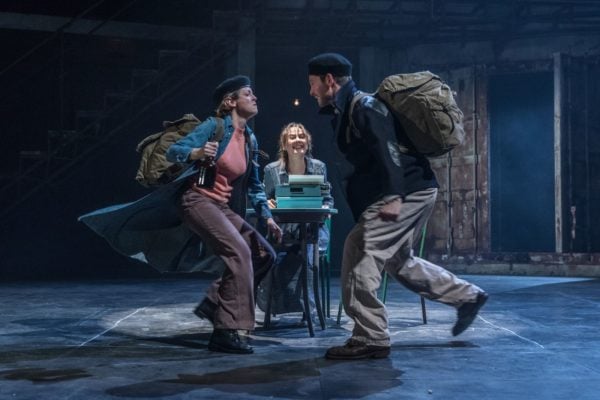
When Lena imagines herself in her mind, her actual appearance is not what she pictures. Lena is chubby. Glasses cover her eyes, acne covers her skin. She’s coming of age in a poor and violent suburb of Naples, being hurled towards adulthood, while grasping – as if for a branch in a hurricane – for childhood and a world where time stays still. Adulthood is frightening. It disables like her mother’s limp. It suffocates with the claustrophobia of domesticity and aches with the disappointment of abandoned dreams. Growing up seems, for Lena, what it is for most girls, a winding on of constraints and obligations, an application of social pressure and a submission to its conformity.
Adolescence is the jarring in-between. It’s the time before the substance of our identities hardens into the adults we fear becoming. A present yet fleeting moment of tumult, it offers a final window of hope to shape our lives, our minds, before they ossify into their mature and unchangeable forms.
“My Brilliant Friend” is a journey through the secret thoughts, memories and confessions swirling in Lena’s mind. Paced by the ever-increasing speed of change, the novel exudes uncertainty. At nearly every point in the narrative, Lena is struggling to define her self-worth – and herself. Though she is sought after by boys and praised by teachers, she questions her beauty, her intelligence and her merits. Though she is deeply introspective and thoughtful, she fears being wrong or seeming stupid. Lena’s challenge is Sisyphean, to overcome within herself that which always tells her she is behind. Author Elena Ferrante pours out these insecurities with prose you could drink, but digesting the plight of the young protagonist would be exhausting if it weren’t so acutely familiar.
As a freshman last year, I remember sitting in class with the previous night’s reading whirling in my mind. I had argued over the ideas with my friends last night, ruminated over their meaning. Yet when prompted for questions or comments, my hand stayed resolutely lowered, my mouth steadfastly closed. My piece, which teetered at the tip of my tongue, was knocked off balance by the frenzy of thoughts chasing each other in circles, each one critical of the last. While a hurricane ravaged through my mind, the professor calmly registered the silence and moved on.
Later on, I approached a friend of mine to ask about this phenomenon that followed me from class to class. It felt as if something inside of me were ordering me to stay silent, lest I be wrong, lest my question contain the slightest redundancy. No matter how much I dedicate myself to the material, self-doubt always seemed to creep in. To my surprise, my friend told me that she was experiencing the exact same thing. We resolved that introspecting, overanalyzing, somehow always made us weaker. It set one part of ourselves against another, and left us in a haze, not knowing which “self” to trust.
Like young Lena, we lacked – and perhaps feared – the conviction required to assert our opinions, and thus ourselves. Fearing that we become, inadvertently, what we did not wish to be. Fearing that a false statement might crystallize into a false impression. In general, we just feared.
The world offers a lot for a girl to fear. The threat of violence, abuse, loss of agency or denial of self-fulfillment, all are ominous concerns thumping in the background of “My Brilliant Friend,” and while it’s easy to learn to fear, girls, in particular are much more hard pressed to find models of overcoming it without submitting to artificially mimicking the trope of male supremacy.
On this point, Ferrante offers a brilliant case study. Lila, Lena’s self-assured and powerful friend, doesn’t fear wielding a knife on those who cross her. She dominates with her intellect, and eviscerates all doubt directed at her through forceful outbursts of aggression and merciless cruelty. However, Lila’s extreme displays of courage seem to hint that beneath them lay profound unrest. Midway into her adolescence, she begins experiencing a feeling she calls “dissolving boundaries,” when all around her, people, objects lose their shape and seem but a mass of particles, spilling out of their original forms. The storm of adolescence ravages, leaving nothing behind as it was. Lila’s ambition devolves into doubt, and her courage eventually gives in to fear. She commits herself to provincial life and dismisses the prospect of moving away from her impoverished, lethargic town.
Suppressing self-doubt does not get rid of it, and the contrast between the two friends finally exposes itself in the way the girls respond to self-critique. Whereas Lena grew up and adapted under the constant pressure of crushing self-doubt, for Lila, the shock of finally admitting to such uncertainty, was irreparably destructive.
After reading the first novel in Ferrante’s series, I met with my friend from freshman year once again. She had been reading an entry in the Stanford Encyclopedia of Philosophy published a few days prior that seemed to translate exactly what we felt into a polished jargon, as if our recurring dispositions were legitimate academic methodology. The entry is titled “Epistemic Self-Doubt,” and dubs the state of the split, doubting self, as one of “epistemic akrasia.”
The entry sheds light on what it means to be a constantly self-critiquing and doubting being. It notes that while splitting oneself into two factions is not the most straightforward means of existence, it’s almost not a state of perpetual moral tempest, and by all means, is extremely possible to simply live with. Lena’s not a role model – no one in Ferrante’s books is. She never solves the problem of self-doubt, but she does move forward despite it. Her ability to keep going despite her flaws is her most commendable trait, one that fellow epistemic akrasiacs are wont to take note of.
Contact Anna-Sofia Lesiv at alesiv ‘at’ stanford.edu.
